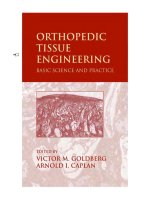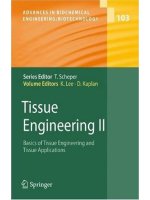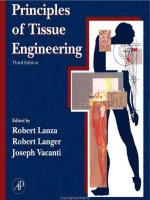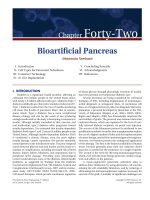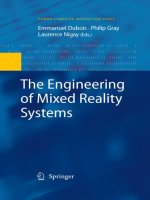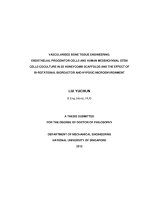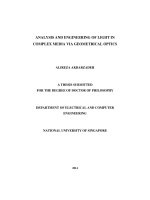Tissue engineering of ligament through rehabilitative mechanical conditioning of mechano active hybrid silk scaffolds
Bạn đang xem bản rút gọn của tài liệu. Xem và tải ngay bản đầy đủ của tài liệu tại đây (17.58 MB, 300 trang )
TISSUE ENGINEERING OF LIGAMENT THROUGH
REHABILITATIVE MECHANICAL CONDITIONING OF
MECHANO-ACTIVE HYBRID SILK SCAFFOLDS
Teh Kok Hiong, Thomas
B.Eng. (Hons.), NUS
A THESIS SUBMITTED FOR THE DEGREE OF
DOCTOR OF PHILOSOPHY
DIVISION OF BIOENGINEERING
NATIONAL UNIVERSITY OF SINGAPORE
2010
Page | i
Preface
Preface
This thesis is submitted for the degree of Doctor of Philosophy in the Division
of Bioengineering at the National University of Singapore under the supervision of
Associate Professor Toh Siew Lok and Professor James Goh Cho Hong. No part of this
thesis has been submitted for other degree at other university or institution. To the best
of the author’s knowledge, all the work presented in this thesis is original unless
reference is made to other works. Parts of this thesis have been published or presented
in the List of Publications shown in the subsequent section.
Teh Kok Hiong, Thomas
Singapore, July 2010
Page | ii
List of Publications
List of Publications
International Journal Publications
1. Toh SL, Teh TKH, Vallaya S, Goh JCH. Novel silk scaffolds for ligament tissue
engineering applications. In: Lee SB, Kim YJ, editors. Experimental Mechanics in
Nano and Biotechnology, Pts 1 and 2, 2006. p. 727-730.
2. Teh TK
, Toh SL, Goh JC. Optimization of the silk scaffold sericin removal process
for retention of silk fibroin protein structure and mechanical properties. Biomed
Mater 2010; 5(3):035008.
3. Teh TK
, Toh SL, Goh JC. Aligned Hybrid Silk Scaffold for Enhanced
Differentiation of Mesenchymal Stem Cells into Ligament Fibroblasts. Tissue Eng
Part C Methods 2011.
4. Sahoo S, Teh TK, He P, Toh SL, Goh JC. Interface Tissue Engineering: Next Phase
in Musculoskeletal Tissue Repair. Annals, Academy of Medicine, Singapore 2011;
40(5).
5. Shi P, He P, Teh TK, Morsi YS, Goh JCH. Parametric analysis of shape changes of
alginate beads. Powder Technology 2011; 210:60.
Page | iii
List of Publications
International Conferences
1. Teh TK, Toh SL, Goh JC. Novel Knitted Silk Scaffolds with Electrospun PLGA for
Ligament Tissue Engineering Applications. (6
th
International Symposium on
Ligaments & Tendons, Chicago IL, Mar 2006)
2. Toh SL, Teh TKH, Vallaya S, Goh JCH. Novel Silk Scaffolds for Ligament Tissue
Engineering Applications. (The International Conference on Experimental
Mechanics 2006. The 5
th
Asian Conference on Experimental Mechanics (ACEM5),
Jeju , Korea, Sep 2006)
3. Teh TK, Toh SL, Kyaw M, Goh JC. Advanced Bioreactor System for Tendon or
Ligament Regeneration. (2
nd
International Symposium on Biomedical Engineering,
Bangkok, Thailand, Nov 2006)
4. Teh TK, Toh SL, Goh JC. Novel Nano-microfibrous Silk Scaffolds for Tendon-
ligament Tissue Engineering Applications. (2
nd
Tohoku-NUS Joint Symposium on
the Future Nano-medicine and Bioengineering in East-Asian Region, Singapore,
Dec 2006)
5. Teh TK
, Goh JC, Toh SL. Advanced Nano-micro Fibrous Silk Scaffold System for
Tendon/Ligament Tissue Engineering. (International Society of Biomechanics XXI
Congress, Taipei, Taiwan, 1 – 5 July 2007)
Page | iv
List of Publications
6. Teh TK, Goh JC, Toh SL. Characterization of Nano-Microfibrous Knitted Silk
Hybrid Scaffold Systems for Tendon/Ligament Tissue Engineering Applications.
(3rd WACBE World Congress on Bioengineering, Bangkok, Thailand, 9 – 11 July
2007)
7. Teh TK, Goh JC, Toh SL. The Effects of Nanofibers Arrangement in a Novel
Hybrid Knitted Silk Scaffold System for Tendon/Ligament Tissue Engineering
Applications. (Tissue Engineering & Regenerative Medicine International Society
Asian-Pacific Chapter Meeting 2007, Tokyo, Japan, 3 – 5 December 2007)
8. Teh TK, Goh JC, Toh SL. The Effects of Nanofibers Arrangement on BMSC
Growth in a Hybrid Knitted Silk Scaffold System for Tendon/Ligament Tissue
Engineering Applications. (3rd Tohoku-NUS Joint Symposium on Nano-Biomedical
Engineering in the East Asian-Pacific Rim Region, Singapore, 10 – 11 December
2007)
9. Teh TK, Goh JC, Toh SL. Comparative Study of Random and Aligned Nanofibrous
Scaffolds for Tendon/Ligament Tissue Engineering. (7th Asian-Pacific Conference
on Medical and Biological Engineering, Beijing, China, 22-25 April 2008)
10. Teh TK
, Goh JC, Toh SL. Comparative Study of Random and Aligned Submicron
Fibrous Scaffolds for Tendon/Ligament Tissue Engineering. (16th Congress of the
European Society of Biomechanics, Lucerne, Switzerland, 6-9 July 2008)
Page | v
List of Publications
11. Teh TK, Goh JC, Toh SL. Aligned Electrospun Substrates for Ligament
Regeneration using Bone Marrow Stromal Cells. (Tissue Engineering and
Regenerative Medicine International Society Asian-Pacific Chapter Meeting 2008,
Taipei, Taiwan, 6-8 November 2008)
12. Teh TK, Goh JC, Toh SL. Characterization of Electrospun Substrates for Ligament
Regeneration using Bone Marrow Stromal Cells. (13th International Conference on
Biomedical Engineering, Singapore, 3-6 December 2008)
13. Teh TK, Toh SL, Goh JC. A comparative study of different mechanical conditioning
regimes for the development of tissue engineered anterior cruciate ligament. (Tissue
Engineering and Regenerative Medicine International Society Asian-Pacific Chapter
Meeting 2010, Sydney, Australia, 15-17 September 2010). *Best Poster Award (3
rd
Prize)
14. Teh TK, Toh SL, Goh JC. Rehabilitative Mechanical Conditioning Regime for
Tendon/Ligament Tissue Regeneration. (11
th
International Symposium on
Ligaments and Tendons, Long Beach, California, USA, 12 January 2011) *Finalist
for Savio L-Y. Woo Young Researcher Award
Page | vi
Acknowledgements
Acknowledgements
I would like to express my deepest gratitude to my mentors, Associate Professor
Toh Siew Lok and Professor James Goh, who have led and inspired me towards
research in the exciting and multidisciplinary field of tissue engineering and
orthopaedic research. I am blessed to have their tireless support and guidance through
the years of academic pursuit in the National University of Singapore. I am also grateful
to the committee members of my qualifying examination, Prof Lim Chwee Teck and
Associate Professor Tong Yen Wah, for their guidance and valuable feedback on this
research undertaking. I am deeply appreciative of Dr Liu Haifeng and Dr Fan Hongbin,
who as my post-docs, assisted and guided me in the early days of my research pursuit.
This project would not have been realized if not for the help, support and valuable
discussion made with my colleagues at the Tissue Repair Lab and NUSTEP Lab.
Special thanks have to be given to our Laboratory Technologists, Ms Lee Yee Wei and
Ms Serene Goh, who have conscientiously ensured that the lab is always in order and
have supported efficiently in the logistical aspect of this study. I would like to thank my
fellow lab mates, Moe, Zheng Ye, Sambit, Bibhu, Eugene, Kian Siang, Peng Fei, Kelei,
Pamela, Yuwei and Sujata for their support through both the exhilarating and
challenging times of my research pursuit. Acknowledgement also needs to be given to
the four undergraduate students, Sin Chang, Joanne, Zhihong and Alfred, who have
assisted in parts of this study as fulfillment of their final year projects.
I would like to thank Mdm Zhong Xiangli from the Materials Lab for her help in
SEM characterizations, Mr Chiam from the Experimental Mechanics Lab for his help in
Page | vii
Acknowledgements
the fabrication of jigs and components of the electrospinning and bioreactor setups, Dr
Zhang Yanzhong and Hock Wei for their help in the biomechanical characterizations,
Ms Eunice Tan from the Nano Biomechanics lab for her help in nano mechanical
characterizations, and lastly Ms Amy Chee and Mr Cheng from the Dynamics Lab for
their help in the use of the mechanical vibrator for degumming.
Last but not least, I am extremely grateful to my parents who have supported and
nurtured me through my life. Together with my sister, Michelle, they have been my
pillar of support through happiness and woes in my life endeavors. Another pillar of
support of mine is my wife, who not only shares my enthusiasm and aspiration in
research, but also bears undying faith in my abilities. Thank you, Erin, for trusting in me
even in the most difficult of times.
Page | viii
Summary
Summary
The use of appropriate mechanically viable scaffold and the provision of
appropriate biophysical environment has always been one of the keys to successful
regeneration of ligament tissues. With the aim to biomimic the native environment, an
aligned hybrid silk fibroin (SF) scaffold and a rehabilitative mechanical conditioning
regime were studied. It was hypothesized that the mechano-active hybrid SF scaffold
(AL) consisting of knitted SF integrated with aligned SF electrospun fibers (AL-SFEF)
could enhance tissue regeneration by first promoting cellular alignment, which in turn
facilitated effective mechano-transduction when the cell-seeded AL scaffolds were
mechanically conditioned rehabilitatively. The study was grouped into four stages: (i)
design and development of the SF knit, (ii) development of the AL scaffold, (iii) in vitro
characterization of the AL scaffold, and (iv) rehabilitative mechanical conditioning of
the AL scaffolds.
The first stage involved evaluation of the SF mechanical properties as an initial
step to the design of the SF knit. Upon selecting the mechanical properties of the
optimally degummed SF fibers, design of the SF knit revealed that 240 SF count was
necessary. The designed silk knits were subsequently optimally degummed for overall
structural/mechanical properties retention and effective sericin removal.
The second stage then involved electrospinning SFEF meshes and physically
incorporating them to the knitted SF. Highly aligned SFEF meshes were obtained by
using a customized electrospinning setup. The meshes were subsequently integrated
physically with the SF knit via sequential and localized application of methanol to
Page | ix
Summary
produce inherent contractile forces of the SFEF meshes. Characterization of the
completed hybrid SF scaffolds revealed that the AL scaffolds had SFEF meshes well-
integrated with the knitted structure and were mechanically superior.
The third stage involved in vitro characterization of the AL scaffolds using rabbit
mesenchymal stem cells (MSCs). It was shown that the AL scaffolds stimulated
increased proliferation and collagen synthesis via providing favorable topographical
conditions for cell and ECM alignment. Consequently, cells expressed up-regulation of
ligament-related genes and deposition of the related ECM components, which were
indicative of a differentiative phase. Mechanically superior AL constructs were obtained
after 14 days of culture. These effects were intensified synergistically when the
mechano-active AL scaffolds were dynamically cultured.
The fourth stage involved the optimization of the mechanical stimulation approach
to further enhance tenogenic differentiation. Dynamic conditioning was also performed
over a longer duration to examine its prolonged effect on MSC differentiation and
development in the AL hybrid SF scaffold. Leveled mechanical stimulation regimes
were used to compare with the rehabilitative approach, which in contrast with level state
stimulations, involved gradual application of dynamic cues with increasing intensities in
terms of cyclic frequency. Through the up-regulation and deposition of ligament-related
genes and ECM components, it was shown that the rehabilitative approach to dynamic
conditioning AL scaffolds allowed timely introduction of appropriate stimulation
intensities, which allowed early introduction of the synergistic mechanical cues to the
MSC-seeded mechano-active AL scaffold to effect an accelerated tenogenic profile.
Page | x
Table of Contents
Table of Contents
Preface i
List of Publications ii
Acknowledgements vi
Summary viii
Table of Contents x
List of Abbreviations xviii
List of Tables xxii
List of Figures xxv
Chapter 1 Introduction 1
1.1. Background and Significance 2
1.2. Objectives 7
1.3. Scope of Dissertation 9
Chapter 2 Literature Review 11
2.1. Introduction 12
2.2. Ligament Anatomy and Function 12
2.3. Biochemical Constituents of Ligament 16
2.4. Mechanical Properties 16
2.4.1. Structural Properties 17
2.4.2. Time- and History-Dependent Viscoelastic Properties 20
2.5. Ligament Injury 22
2.5.1. Mechanism of injury 22
2.5.2. Healing of Ligament Injuries 23
Page | xi
Table of Contents
2.6. Current Treatment Modalities 25
2.6.1. Permanent Grafts 26
2.6.2. Biological Grafts 29
2.6.3. Biodegradable Grafts 31
2.7. Tissue Engineered Ligament Grafts 33
2.7.1. Cells 36
2.7.2. Scaffold 39
2.7.2.1. Common Ligament Tissue Engineering Scaffold Materials 40
2.7.2.2. Silk Fibroin as Ligament Tissue Engineering Scaffold Material 43
2.7.2.3. Scaffold Architecture 47
2.7.2.4. Scaffold Topography 49
2.7.3. Biomechanical Cues 50
2.8. Summary 56
Chapter 3 Design and Development of the Silk Fibroin Knit 58
3.1. Introduction 59
3.2. Mechanical Properties of SF from Degummed Silk Yarns 60
3.2.1. Materials and Methods 60
3.2.1.1. Sample Preparation and Degumming 60
3.2.1.2. Observation of SF Morphology and Cross-Section 61
3.2.1.3. Nanotensile Tests 61
3.2.1.4. Statistical Analysis 62
3.2.2. Results and Discussion 63
3.2.2.1. Degummed Silk Morphology 63
3.2.2.2. Cross-Sectional Area 64
Page | xii
Table of Contents
3.2.2.3. SF Mechanical Properties 65
3.3. Design of Knitted SF Architecture 68
3.3.1. Design Purpose and Specifications 68
3.3.2. Design Development 69
3.3.3. Summary of Design Outcome 74
3.4. Optimization of Knitted SF Degumming 75
3.4.1. Introduction 75
3.4.2. Materials and Methods 76
3.4.2.1. Sample Preparation and Degumming 76
3.4.2.2. Observation of SF morphology 82
3.4.2.3. Single Fibroin Mechanical Test 82
3.4.2.4. Knitted SF Mechanical Test 83
3.4.2.5. Silk Protein Identification and Fractionation using SDS- PAGE 85
3.4.2.6. Conformational Structure Analysis of Degummed SF using FTIR-ATR .
88
3.4.2.7. Statistical Analysis 89
3.4.3. Results 89
3.4.3.1. Degummed SF Morphology 89
3.4.3.2. Degummed SF Mechanical Properties 91
3.4.3.3. Degummed SF Knit Mechanical Properties 95
3.4.3.4. Silk Protein Identification and Fractionation 96
3.4.3.5. Degummed SF Conformational Structure Analysis 99
3.4.4. Discussion 100
Page | xiii
Table of Contents
3.4.4.1. Rationale for Mechanically Testing Both Single SF Filaments and
Knitted SF 101
3.4.4.2. Effects of Prolonged Degumming 102
3.4.4.3. Effects of Mechanical Agitation during Degumming 104
3.4.4.4. Effects of Thermal Conditions during Degumming 105
3.4.4.5. Effects of Refreshing Degumming Solution 106
3.4.4.6. Effects of Post-Degumming SF Protein Structural Modification 107
3.4.4.7. Sericin Removal Efficiency 109
3.5. Concluding Remarks 113
Chapter 4 Development and Characterization of the Mechano-active Hybrid Silk
Fibroin Scaffold 114
4.1. Introduction 115
4.2. Materials and Methods 116
4.2.1. Fabrication of Hybrid SF Scaffolds 116
4.2.2. Scaffold Characterization 124
4.2.3. Isolation and Culture of MSCs 125
4.2.4. Standalone Bioreactor for Dynamic Culture 126
4.2.4.1. Environmental Control System 128
4.2.4.2. Multidimensional Strain Control System 132
4.2.5. MSC-seeded Scaffolds Cultured in Static and Dynamic Conditions 135
4.2.6. Cell Seeding Efficiency, Viability and Proliferation 137
4.2.7. Cell Morphology 138
4.2.8. Collagen Quantification 138
4.2.9. Histological Assessment 139
Page | xiv
Table of Contents
4.2.10. Real-Time qRT-PCR Analysis 139
4.2.11. Western Blot Analysis 139
4.2.12. Biomechanical Test on Cultured Hybrid Scaffolds 140
4.2.13. Statistical Analysis 140
4.3. Results 141
4.3.1. Hybrid SF Scaffold Morphology 141
4.3.2. SFEF Orientation 143
4.3.3. Conformational Analysis of SF, SFEF and Hybrid SF Scaffold 144
4.3.4. Tensile Properties of AL and RD Hybrid Scaffolds 146
4.3.5. Cell Adhesion, Viability and Proliferation 147
4.3.6. Cell Morphology 148
4.3.7. Collagen Synthesis 152
4.3.8. Histological Analysis 153
4.3.9. Gene Expression of Ligament-related ECM Proteins using Real-Time
qRT-PCR 156
4.3.10. Western Blot Analysis 159
4.3.11. Tensile Properties of Cultured Hybrid Scaffolds 162
4.4. Discussion 165
4.4.1. Knitted Mesh of the AL Hybrid SF Scaffold 166
4.4.2. AL-SFEF of the AL Hybrid SF Scaffold 167
4.4.3. Mechano-Active AL Hybrid SF Scaffold Improved Cell Viability and
Proliferation 169
4.4.4. Mechano-Active AL Hybrid SF Scaffold Improved Cell/ECM
Alignment and Collagen Fiber Formation 170
Page | xv
Table of Contents
4.4.5. Improved Mechanical Properties of MSC-Seeded Mechano- Active AL
Hybrid SF Scaffold 171
4.5. Concluding Remarks 174
Chapter 5 Rehabilitative Mechanical Conditioning of the Mechano-active Hybrid
Silk Fibroin Scaffold 175
5.1. Introduction 176
5.2. Materials and Methods 177
5.2.1. Fabrication of AL Hybrid SF Scaffolds 177
5.2.2. Isolation and Culture of MSCs 178
5.2.3. MSC-seeded AL Scaffolds Cultured in Different Dynamic Conditioning
Regimes and Static Conditions 178
5.2.4. Cell Viability and Proliferation 180
5.2.5. Collagen Quantification 181
5.2.6. Histological Assessment 181
5.2.7. Real-Time qRT-PCR Analysis 182
5.2.8. Western Blot Analysis 183
5.2.9. Biomechanical Test 183
5.2.10. Statistical Analysis 183
5.3. Results 184
5.3.1. Results from Optimization of Mechanical Stimulation Regime 184
5.3.1.1. Cell Viability and Proliferation 184
5.3.1.2. Collagen Synthesis 185
5.3.1.3. Histological Analysis 187
Page | xvi
Table of Contents
5.3.1.4. Gene Expression of Ligament-related ECM Proteins using Real-Time
qRT-PCR 191
5.3.1.5. Tensile Properties of Dynamically Cultured AL Hybrid Scaffold using
Different Stimulation Regimes 193
5.3.2. Results from Characterization of the “Rehab” Mechanical Stimulation
Regime 196
5.3.2.1. Cell Viability and Proliferation 196
5.3.2.2. Collagen Synthesis 197
5.3.2.3. Histological Analysis 198
5.3.2.4. Gene Expression of Ligament-related ECM Proteins using Real-Time
qRT-PCR 200
5.3.2.5. Western Blot Analysis 201
5.3.2.6. Tensile Properties of Dynamically Cultured AL Hybrid Scaffold using
the “Rehab” Conditioning Regime 203
5.4. Discussion 205
5.4.1. Determination of the Onset of Specific Mechanical Stimulation Profiles
in the Rehabilitative Approach 206
5.4.2. Suitability of the “Rehab” Regime for Prolonged Mechanical
Stimulation 208
5.4.3. “Rehab” Stimulation Regime for Regenerated Ligament Tissue
Maturation 210
5.5. Concluding Remarks 213
Chapter 6 Conclusion and Recommendations 214
6.1. Conclusion 215
Page | xvii
Table of Contents
6.2. Recommendations for Future Work 217
6.2.1. Cell Migration Aided by SFEF Alignment 217
6.2.2. Improvement of Cell Infiltration into the Hybrid SF Scaffold 217
6.2.3. Sequential Release of Specific Growth Factors through Designed
Incorporation into Electrospun Fibrous Meshes of Different Materials
219
References 221
Appendix A. Method for determining elastic region 243
Appendix B1. Live/dead Hemocytometry 246
Appendix B2. Alamar Blue™ 248
Appendix B3. Texas Red-X Phalloidin/DAPI Fluorescence Staining 250
Appendix B4. Sircol™ Collagen Assay 251
Appendix B5. Histological Assessments 253
a. H&E Staining 253
b. Masson's Trichrome Staining 254
c. Immunohistochemical Staining 254
Appendix B6. Real-time qRT-PCR 256
Appendix B7. Western Blot 258
Appendix C. Bioreactor Environmental Feedback Control Mechanism 259
Page | xviii
List of Abbreviations
List of Abbreviations
2D 2 Dimensional
3D 3 Dimensional
ACL Anterior Cruciate Ligament
AD Angular Deviation
AL Aligned/Aligned Hybrid Silk Fibroin Scaffold
AL-SFEF Aligned Silk Fibroin Electrospun Fibers
ANOVA Analysis of Variance
bFGF Basic Fibroblast Growth Factor
BMSCs Bone Marrow Stromal Cells
cDNA Complementary DNA
CFU-F Colony Forming Unit for Fibroblast
CO
2
Carbon Dioxide
DAB 3, 3' diaminobenzidine
DAC Data Acquisition Card
DAPI 4´, 6-diamidino-2-phenylindole, dihydrochloride
DMEM
Dulbecco’s Modified Eagle Medium
DNA Deoxy Ribonucleic Acid
DO Dissolved Oxygen
DTT Dithiothreitol
E Young’s Modulus
ECL Enhanced Chemiluminescence
ECM Extracellular Matrix
ES Elastic Stiffness
Page | xix
List of Abbreviations
FBS Fetal Bovine Serum
FDA Food and Drug Administration of the United States
FTIR-ATR
Fourier-transformed infrared spectroscopy, using the attenuated
total reflection method
GAG Glucosaminoglycans
GAPDH Glyceraldehydes 3-phosphate Dehydrogenase
H Horizontal Length
H&E Hematoxylin and Eosin
HC Heavy Chain
HFIP 1,1,1,3,3,3-hexafluoro-2-propanol
HLA Human Leukocyte Antigen
HLF Human Ligament Fibroblasts
HRP Horseradish Peroxidase
INF-γ Interferon γ
ISCT International Society for Cellular Therapy
LAD Ligament Augmentation Device
LARS Ligament Advanced Reinforcement System
LC Light Chain
LCL Lateral Collateral Ligament
L-PLA L-polylactic Acid
LPS Lipopolysaccharide
MA Mechanical Agitation
MCL Medial Collateral Ligament
MLC Mixed Lymphocyte Culture
MSCs Mesenchymal Stem Cells
Page | xx
List of Abbreviations
MW Molecular Weight
Na
2
CO
3
Sodium Carbonate
NZW New Zealand White
O
2
Oxygen
PBS Phosphate Buffer Solution
PCL Posterior Cruciate Ligament
PDS Polyparadioxanone
PGA Poly(glycolide)
PLAGA Poly(lactide-co-glycolide)
PLLA Poly(L-lactide)
PU Polyurethane
qRT-PCR Quantitative Reverse Transcription Polymerase Chain Reaction
RD Random/Randomly-arranged Hybrid Silk Fibroin Scaffold
RD-SFEF Randomly-arranged Silk Fibroin Electrospun Fibers
RNA Ribonucleic Acid
SD Standard Deviation
SDS Sodium Dodecyl Sulfate
SDS-PAGE Sodium Dodecyl Sulfate-Polyacrylamide Gel Electrophoresis
SEM Scanning Electron Microscope
SER Sericin
SF Silk Fibroin
SFEF Silk Fibroin Electrospun Fiber
SIS Small Intestinal Submucosa
SMC Smooth Muscle Cell
TCP Tissue Culture Polystyrene
Page | xxi
List of Abbreviations
TGF-β Transforming Growth Factor β
UTL Ultimate Tensile Load
UTS Ultimate Tensile Strength
V Vertical Length
Page | xxii
List of Tables
List of Tables
Table 1-1: List of specific factors affecting successful tissue engineering of
ligament with the aspects studied in this project to satisfy them. 7
Table 2-1: ECM composition of ligaments [24, 41, 45, 55]. 16
Table 2-2: Structural properties from the load-elongation curve and stress-strain
curve of ligament [24, 41, 45, 55]. 18
Table 2-3: Mechanical properties of human tendons and ligaments [24, 39, 42, 43,
57-78]. 19
Table 2-4: Synthetic ACL prosthesis with their advantages and disadvantages. 27
Table 2-5: Physical and mechanical properties of the poly(α-hydroxyester) family.
42
Table 3-1: Tensile properties of differently degummed SF fibers (data from ten
degummed samples for each group). 67
Table 3-2: Design specifications for knitted SF. 72
Table 3-3: Tensile properties of SF fibers degummed for 30 min. 72
Table 3-4: Designed knitted SF parameters. 72
Table 3-5: Calculated yield point load and stiffness of SF filament. 73
Table 3-6: Classification of sample groups and the degumming conditions subjected
to each group. The different factors were optimized under different
phases (Phase I: Mechanical agitation, Phase II: Degumming thermal
conditions, Phase III: Use of refreshed solution and Phase IV: Use of
post-degumming SF structural modification). Degumming durations
were varied within each phase. Numbers following “SDS” or “Na
2
CO
3
”
Page | xxiii
List of Tables
of sample group names indicate degumming duration pattern, while
items in bracket indicate degumming temperature and whether
mechanical agitation is present (MA) or absent (Static). 79
Table 3-7: Tensile parameters of differently degummed SF (data from 10
degummed samples for each group) with the data from the group with
optimal degumming highlighted in bold. 93
Table 3-8: Mechanical properties of degummed SF knit using the “SDS30 (100°C,
MA)” degumming condition (n=5). 96
Table 4-1: Electrospinning operating parameters. 122
Table 4-2: Stimulation parameters used for dynamic culture of MSCs-seeded SF
hybrid scaffolds to assess mechano-active effects of AL scaffolds. 137
Table 4-3: Mechanical properties of blank scaffold samples (n=5, data: mean ± SD).
*p<0.05 when compared to knitted SF. 146
Table 4-4: Mechanical properties of statically and dynamically cultured scaffold
samples (n=5, data: mean ± SD). *p<0.05 when compared to RD
scaffolds at each time point of the same culture condition (for static and
dynamic cultures respectively). #p<0.05 when dynamically cultured
scaffolds were compared to the statically cultured equivalent at the same
time point. 162
Table 5-1: Stimulation parameters of the “low” and “high” intensity stimulation
profile used for optimization of the dynamic conditioning regime. 180
Table 5-2: Mechanical properties of dynamically cultured scaffold samples by
different stimulation regimes (n=5, data: mean ± SD). ^p<0.05 when
compared to the previous time point for each group respectively.
Page | xxiv
List of Tables
#p<0.05 when the “rehab” group was compared to both the “continuous
low” and “continuous high” groups at each time point. 193
Table 5-3: Mechanical properties of dynamically cultured scaffold samples using
“rehab” stimulation regime (n=5, data: mean ± SD). ^p<0.05 when
compared to the previous time point for each group respectively.
#p<0.05 when the “rehab” group was compared to statically cultured
group at each time point. 204
Table A-1: Real-time RT-PCR primer sequences 257
Table A-2: Optimized control parameters for temperature control of (A) chambers
and (B) water bath 260
Table A-3: Optimized control parameters for pH control of (A) release valve and (B)
CO
2
valve 261
Table A-4: Optimized control parameters for O
2
control of (A) O
2
valve and (B)
release valve. 262
